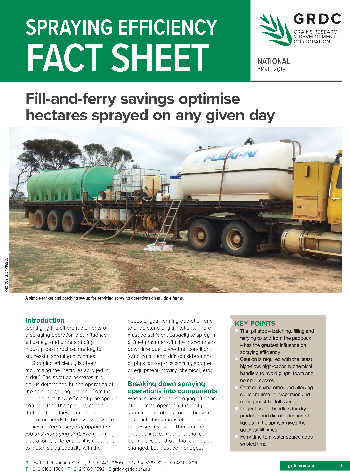Spraying efficiency
Spraying efficiency
Published: 1 Oct 2019
Fill-and-ferry savings optimise hectares sprayed on any given day
Introduction
Identifying the different elements of a spraying operation that influence efficiency, and understanding industry best practice, are key to successful spraying outcomes. Spraying efficiency is about maximising the ‘hectares sprayed in a day’. The sprayed hectares in a day is determined by the operation of the sprayer, getting it to and from the paddock and how efficiently the sprayer can be filled. The spraying capacity that can be achieved in a farming operation needs to be assessed while achieving the best spray application job and managing drift. Every farming operation is different, so it is important to match spray capacity with the needs of your farming operation and to understand any limitations. There must be sufficient capacity to spray in a timely manner with the allowance of downtime due to weather conditions (wind, rain, heat), drift considerations or physical logistics (shifting sprayer or equipment, moving chemical, etc.).
Key points
- The ‘pit stop’– batching, filling and ferrying to and from the paddock – has the greatest influence on spraying efficiency
- Caution is required with the latest high-flow, high-capacity chemical
handlers to avoid glugs, foam and horrible messes - Correct mixing order and allowing sufficient time for dispersion and mixing must be followed
- Diligent use of handlers for dry products and direct induction of liquids in the sprayer gives the quickest fill times
- Ferry time to a water source adds wasted time
Frequently asked questions
Download PDF
Region: National

